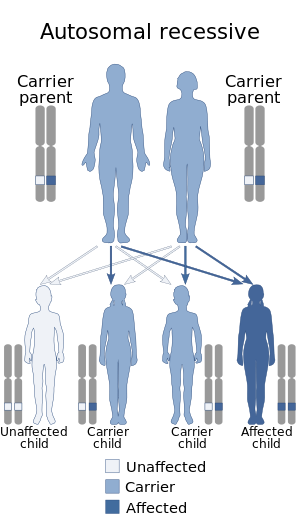Imerslund-Gräsbeck syndrome
| Imerslund–Gräsbeck syndrome | |
|---|---|
| Synonyms | Imerslund–Najman–Gräsbeck syndrome, Imerslund–Gräsbeck disease (IGS or INGS), Imerslund syndrome, Congenital cobalamin malabsorption or Autosomal recessive megaloblastic anemia (MGA1) |
 |
|
| This condition is inherited via an autosomal recessive manner | |
| Classification and external resources | |
| ICD-10 | D51.1 |
| OMIM | 261100 |
| Orphanet | 35858 |
Imerslund–Gräsbeck syndrome, is a rare autosomal recessive, familial form of vitamin B12 deficiency caused by malfunction of the "Cubam" receptor located in the terminal ileum. This receptor is composed of two proteins, amnionless (AMN), and cubilin. A defect in either of these protein components can cause this syndrome. This is a rare disease, with a prevalence about 1 in 200,000, and is usually seen in patients of European ancestry.
Vitamin B12 is an important vitamin needed for bone marrow functioning, the deficit of which causes decreased marrow output and anemia. Vitamin B12 has two forms, one of which, along with folate, is important in DNA synthesis. Vitamin B12 is sensitive to acid deformation in the stomach, so a molecule called (R-factor), protects it in the stomach. In the small bowel, a molecule named intrinsic factor (IF), allows vitamin B12 to be absorbed in the ileum. IGS is caused by a mutation in the receptors located in the terminal portion of ileum. This is a very rare, and unlikely cause of vitamin B12 deficiency but is a cause nonetheless.
Defined as those seen in any macrocytic, megaloblastic anemia:
The disease is autosomal recessive, and can therefore skip generations. Mutations in either amnionless (AMN) or cubilin can be the culprit. Due to its autosomal recessive pattern of inheritance, affected individuals (persons possessing a homozygous recessive genotype) need to undergo genetic counselling to identify risk of family members who might be heterozygous genetic carriers. Certain mutations on the CUBN or AMN (genes that encode cubilin and amnionless respectively) have been identified through genetic analysis, and ethnic susceptibility of some of the mutations were indicated from the current research. It has been further suggested that mutations on CUBN were restricted to exon 1-28 which encoded amnionless binding domains (EGF) and IF-Cbl binding region of cubilin, while AMN mutations primarily clustered in intron 8-11 and transmembrane domain in exon 10. Some interesting aspects of particular mutations were also elucidated by the researchers, for example, CUBN mutation c.3890C>T; p.Pro1297Leu, was considered to be a Finnish founder mutation presenting mostly in homozygous status, while an AMN mutation c.208-2A>G, which was thought to account for 15% IGS cases around the world, was postulated as an ancient founder mutation that can trace back to approximately 13,600 years ago.
...
Wikipedia
